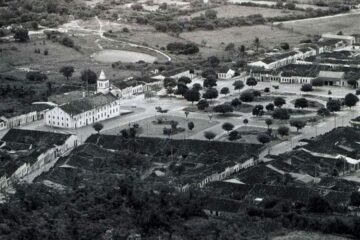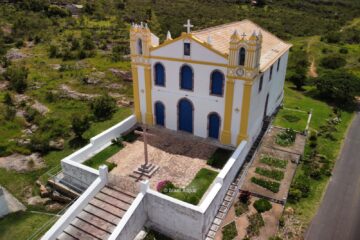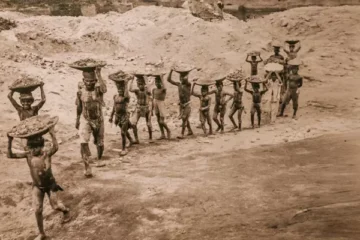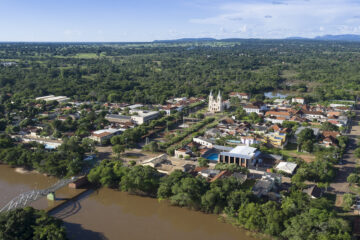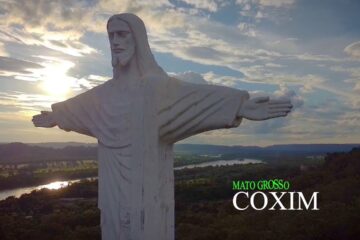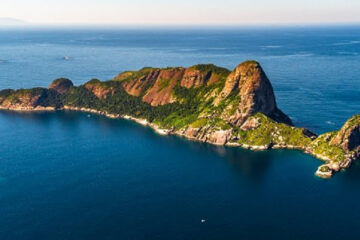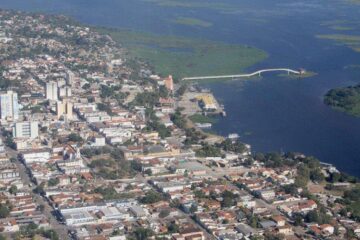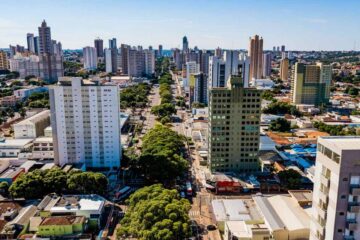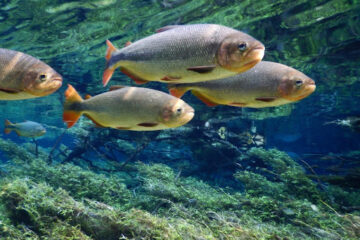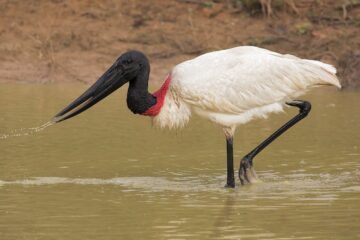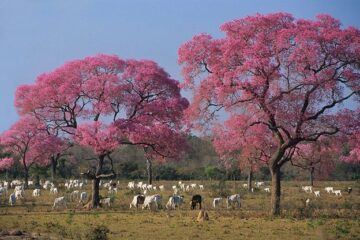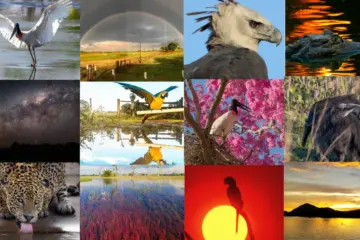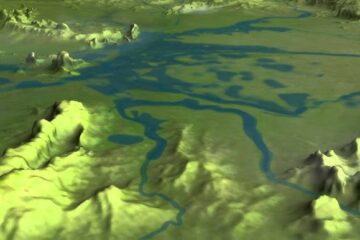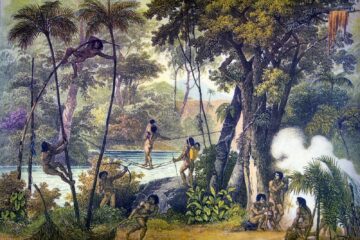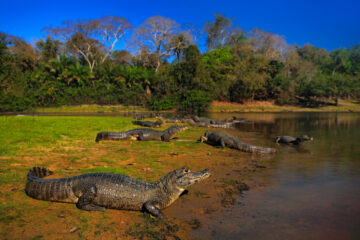Map of South America 1624 “Americae Pars Magis Cognita”, Bry, Theodore de This copper engraving is from a remarkable series of publications, illustrating voyages of discovery and travels of exploration to various parts of the world. The project was begun by Theodore de Bry of Frankfurt, in 1590 and was to […]
Historical Maps
From the 16th century, the historical cartography of Brazil begins with the first representations that are part of the planispheres or maps of the Americas in editions of Ptolemy’s Geography and works by travellers.
These representations of Brazil have illustrations of indigenous scenes, fauna and vegetation, information obtained, at first, through Américo Vespúcio, who accompanied the first Portuguese expeditions to the Brazilian territory, and, later, through travellers and navigators.
The cartography of this period also records the first names of the country: Terra de Santa Cruz, Terra Incógnita, Antropófagos, Terra dos Papagaios and Brasil. These maps were produced by cartographers such as Ruysch, Waldseemüller, Ortelius, Ruscelli, Forlani, Gastaldi and Hulsius. Still in the 16th century, the concern with the French attacks on the Brazilian coast began.
Examples of these episodes can be found in Gastaldi’s maps, exposing the barter between the French navigators and the Brazilian natives, and in the works of the religious and cosmographer André Thevet, who accompanied Nicolas Durand de Villegagnon during the time he was in Rio de Janeiro, with the foundation of the French Antarctic colony.
Between 1580 and 1640, Portugal was part of the Iberian Union, under the Filipino dynasty.
Thus, all the Portuguese colonies also belonged to the Spanish Crown, which favoured the presence of the French, English and Dutch on the northern and north-eastern coast of Brazil.
To defend the Iberian domains in America, the Philippine Crown allowed the Luso-Brazilians to go beyond the limits established by the Treaty of Tordesillas, advancing towards the Amazon delta.
These conquests are recorded in the 17th century Portuguese cartography, by the notable astronomers Cochado and Albernaz I, showing the forts built and the cities founded, as well as the English and Dutch fortifications destroyed.
Still referring to the 17th century, the Portuguese handwritten cartography is displayed, with the charts of Antônio Vicente Cochado, Antônio Sanches, João Teixeira Albernaz I and his grandson João Albernaz II.
All maps detail toponyms richly located on the coast, from Belém to the Rio da Prata.
The map of Brazil by Albernaz II (1666) deserves, however, to be highlighted because, besides having, like the others, a large quantity of toponyms on the Brazilian coast, it highlights the city of São Paulo and, in the south of the territory, the Jesuit missions.
I could not fail to show the beautiful Dutch cartography of north-eastern Brazil, between 1624-1654.
The map, Perfect Caerte der Gelegentheyt van Olinda de Pharnambuco Maurits-stadt ende t’Reciffo and made by Cornelis Golijath, is considered the best cartographic production under Dutch rule in north-eastern Brazil.
In the 18th century, there is a sketch about the Luso-Brazilian explorations of the Brazilian interior, which is part of the set “Cartas Sertanistas” (Letters from the Backlands) (Cortesão, 1957-1971).
These sketches, existing in the National Library, indicate Jesuit missions destroyed by sertanistas and/or bandeirantes and roads in search of mineral wealth in the interior of Brazil.
Still from the 18th century, we also find French cartography, which became predominant in that period with the foundation of the Royal Academy of Sciences by Colbert and the construction of the astronomical observatory in Paris.
Among the cartographers chosen were Guillaume de L’Isle and Jean Baptiste Bourguignon d’Anville, author of one of the best eighteenth-century charts representing South America.
The notoriety of Guillaume de L’Isle is due to the fact that he observed errors of the Portuguese in the calculations of the longitudes of Brazil.
A member of the Royal Academy of Sciences of France, Guillaume de L’Isle, in 1720, noted that the Portuguese calculations exceeded the Lusitanian domains in South America according to the Treaty of Tordesillas.
As is well known, the Iberian Crowns sought a solution to the question of the boundaries of their domains in South America.
The result of these negotiations was the Treaty of Madrid, signed in January 1750.
One of the original copies of the Map of the Cortes, the cartographic document that served as the basis for the treaty, is part of the exhibition.
Thus, mixed commissions were formed to survey and demarcate the borders of the northern and southern regions in South America. Portugal and Spain hired specialists (cosmographers, astronomers, military and other specialists) from various European nations to carry out these tasks.
From these works, a significant amount of cartographic documents (maps, views, reports, diaries) were produced.
The exhibition displays part of this collection produced by the members of these mixed commissions on the Portuguese side.
The 19th century begins with two leaves from the handwritten atlas Guia dos Caminhantes, made by Anastácio de Santana, in Salvador (1817).
The first, the title page, contains geographical data and a panoramic view of the city of Salvador.
The second is a map of Brazil with the north facing the right bank. Besides being didactic, this atlas represents one of the first initiatives in the mapping of Brazil.
In this period, cartographic production increases. Maps of provinces and of the national territory, topographic plans, hydrographic surveys of the rivers, of the Amazon and Prata basins and frontier charts are composed.
In the twentieth century, after resolving several border issues over four centuries, and with the national territory already configured, the route ends with the Carta geographica do Brasil (Geographic Chart of Brazil), on the scale 1:7,500,000, published by the Engineering Club in 1922, in commemoration of the centenary of Brazil’s Independence.
This map is the reduction of the letter of Brazil in the International Letter of the World to the Millionth, made according to international standards established at the International Congress of Geography in Paris in 1913.
Map of Captaincies of Ceara and Pernambuco 1680
Mapa da Capitania de Pernambuco e Ceará de 1680 – Atlas Novus “Capitaniae de Cirii, et Parnambuco”, Jansson, Jan This rare chart of the Captaincies of Ceara and Pernambuco extends from the Rio Formosa to the Rio Estremo and is centered on the Rio de San Francisco. Much information is derived […]
Olinda – Brazil – 1671 – De Nieuwe en Onbekende Weereld
Olinda – Brazil – 1671 – De Nieuwe en Onbekende Weereld “[Povo [with] Villa d Olinda d Pernambuco]”, Montanus, Arnoldus Montanus’ work was perhaps the greatest illustrated book on the New World produced in the seventeenth century. It contained over one hundred beautifully engraved plates, views, and maps of North and […]
Map of Recife – Brazil – 1764
Recife – Brazil 1764 (circa) – Publication: Le Petit Atlas Maritime… Vol. 2 No. 50 “Plan de Fernambouc a la Coste de Bresil”, Bellin, Jacques Nicolas This handsome map shows the area around Recife (Pernambuco), extending north to include Olinda. There are depth soundings, anchorages, and rocks shown, along with several navigational […]
Map of Recife – Brazil – 1679
Map of Recife – Brazil – 1679 “Mauritiopolis Reciffa, et Circumiacentia Castra”, Merian, Matthaus A rare bird’s-eye plan of the city of Recife and environs with emphasis on the Dutch fortifications. Although first founded by the Portuguese, the Dutch decided to invade several cities in Pernambuco due to the local sugarcane […]
Olinda – Brazil – 1633
Olinda – Brazil – 1633 – Warhafftige Beschreibung aller denckwurdigsten Geschichten “Pascaert van de ghelegentheyt van Parnambuc betrocken door Hessel Gerritsz”, Visscher, Claes Janszoon This is a rare and fascinating bird’s-eye view of Olinda and the coast of Pernambuco based on the work of Hessel Gerritsz, who is credited in the title. […]
Map of Brazil 1700
Map of Brazil 1700 “Accuratissima Brasiliae Tabula”, Hondius/Schenk & Valck This handsome decorative map of Brazil is oriented with north to the right. Two insets show Dutch interests in the area (Baja de Todos los Sanctos & Pernambuco). The interior is largely devoid of geographical information; instead it features scenes of […]
Map of Western Hemisphere – America 1587 – Theatrum Orbis Terrarum
Map of Western Hemisphere – America 1587 – Theatrum Orbis Terrarum Ortelius’ Influential Map of the New World in Full Contemporary Color “Americae sive Novi Orbis, Nova Descriptio”, Ortelius, Abraham This is one of the most famous maps of America and one that had enormous influence on the future cartography of […]
Map of Western Hemisphere – America 1628
Map of Western Hemisphere – America 1628 – Gerardi Mercatoris – Atlas sive Cosmographicae… Hondius’ Important Map of the Americas “America”, Hondius, Jodocus Jodocus Hondius’ map of the Americas is one of the most elaborate examples of fine Dutch cartography. The decorations, including sea monsters, indigenous birds, native canoes and sailing vessels, […]
Map of Western Hemisphere – America 1643
Map of Western Hemisphere – America 1643 – Theatre du Monde ou Nouvel Atlas Blaeu’s Stunning Carte-a-Figures Map of the Americas “Americae Nova Tabula”, Blaeu, Willem This stunning carte-a-figures map is a superb example of the fine art of decorative cartography and a seventeenth-century European view of the New World. The […]
Map of Western Hemisphere – America 1677
Map of Western Hemisphere – America 1677 Visscher’s Classic Map of the Americas with the Island of California in Full Contemporary Color “Novissima et Accuratissima Totius Americae Descriptio”, Visscher, Nicolas Visscher’s map greatly influenced the cartography of the Americas both geographically and artistically. One of the most distinctive geographic details […]
Map of Western Hemisphere – America 1727
Map of Western Hemisphere – America 1727 Attractive Map of the Americas with Land Bridge to Asia “Recentissima Novi Orbis sive Americae Septentrionalis et Meridionalis Tabula”, Ottens/De Wit This is the curious third state of this beautiful map of the Americas and an interesting version in this series of maps inspired […]
Map of Western Hemisphere – America 1628
Map of Western Hemisphere – America 1628 – Gerardi Mercatoris Atlas sive Cosmographicae Hondius’ Important Map of the Americas “America”, Hondius, Jodocus Jodocus Hondius’ map of the Americas is one of the most elaborate examples of fine Dutch cartography. The decorations, including sea monsters, indigenous birds, native canoes and sailing vessels, […]
Map of Western Hemisphere – America 1713
Map of Western Hemisphere – America 1713 – Le Nouveau Theatre du Monde… Features a Large Island of California “L’Amerique Selon les Nouvelles Observations de Messrs. de l’Academie des Sciences, Etc.”, Aa, Pieter van der A highly decorative and detailed map of the Americas with the island of California prominently depicted […]
Map of Western Hemisphere – America 1609
Map of Western Hemisphere – America 1609 – Gerardi Mercatoris – Atlas sive Cosmographicae Hondius’ Important Map of the Americas “America”, Hondius, Jodocus Jodocus Hondius’ map of the Americas is one of the most elaborate examples of fine Dutch cartography. The decorations, including sea monsters, indigenous birds, native canoes and sailing vessels, […]
Map of Western Hemisphere – America 1714
Map of Western Hemisphere – America 1714 Uncommon Map with Interesting Geographical Myths “Nouvelle Carte de l’Amerique, avec tous ses Royaumes, Etats, Iles, Ports, Bayes et Rivieres, Dressee Suivant les Plus Nouvelles Decouvertes par les Habiles Geographes…”, Aa, Pieter van der Van der Aa’s uncommon map of the Americas was […]
















